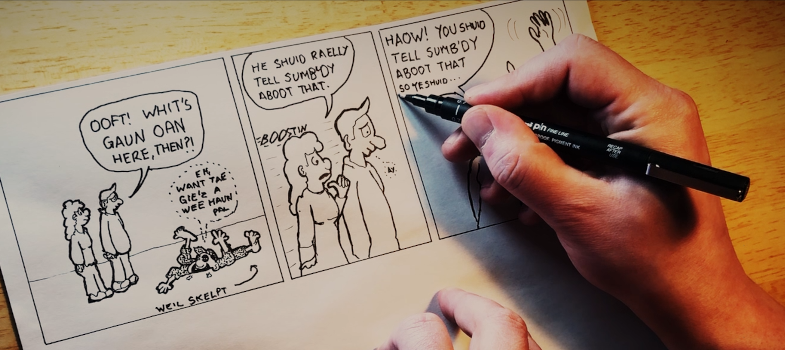Model Answer Unit 2.6 Activity 8
We have put together a list of extracts from the article which we think summarise some of its key points well. You might have selected other aspects.
- ‘taking on culturally authorized evaluative perspectives and judgements about how to be in and act on the world they are voicing wider social attitudes, which may or may not be their own but which are acting powerfully upon them in their developing sense of self and identity.
- this may reveal stereotypes of roughness, i.e. lack of social refinement, associated with use of Scots.
- All of this reveals an unintended implication of the exercise the boys are engaged in, focusing as it does on a list of words presented to them as Scots: namely that their own usage is not Scots.
- Clearly, however, one of the difficulties facing teachers in devising classroom activities for teaching and learning about Scots lies in a tension between a goal of Scots language extension or development – and the materials which are available for this – and one of affirming the Scots which is spoken by pupils.
- Mercer’s (1995) view of the teacher as a ‘discourse guide’, helping learners to ‘go back and forth across the bridge from “everyday discourse” into “educated discourse”’ (1995, 83–4).
- her teacher’s wish to extend and legitimise the use of Scots in the classroom, instead reinforcing the earlier linguistic order. It is therefore clear that messages about legitimate language come not only from the teacher but also from children in the class who have internalised these messages and transmit them to others
- an ‘artificial exercise in nostalgia’ - communicative classroom use of Scots has long been seen as an undesirable disruption of sociolinguistic norms.
- Gibson and Gifford (1997) point out that teachers, who are among those who have gained most from accommodation towards dominant linguistic forms, have not been given the necessary support for critical reflection on the Scottish linguistic order and on the role of schools in maintaining it. They may therefore continue to see Scots as an obstacle to their charges’ educational success and upward social mobility. The result is that they hold ‘divided and dissonant views’ towards their pupils’ speech (Gibson and Gifford 1997, 147).
- teachers may also feel concerned over possibly ‘hostile’ parental reaction to their inclusion of Scots in their classroom teaching (Niven 1998, 67).
- a shared evaluative framework in which contemporary Scots is a matter of some embarrassment, associated with what Niven has described as the ‘Scottish cringe’ (1998, 57).
- the difficulty faced by any Scottish teacher who attempts ‘tae sclim ower the high wa o their ain linguistic condeetionin’ (Hodgart 1997, 87), i.e. to conquer the linguistic conditioning to which they themselves have been exposed throughout their lives.
- As Macafee (1997, 536) points out, this conditioning makes it, ‘difficult, even for those very strongly motivated, to use Scots naturally and spontaneously in unfamiliar registers, for instance public speaking or academic lectures’… struggled with self-consciousness in trying to use it fluently in the classroom, particularly when in the traditional teacher role of addressing the class as a whole.
- Given that positive politeness in Scottish working-class culture takes the form of linguistic accommodation towards Scottish English, ‘aye’, as a token of Scots speech, would seem to signal to teachers disrespect or even defiance on the part of pupils. The usage appears to present a challenge, however unwitting, to the linguistic order of the classroom and therefore to its upholder, the teacher herself.
- Teachers’ reactions may further be connected to the association of contemporary Scots with stigmatised urban vernaculars, and to the quite widespread notion that what linguists consider to be Scots is in fact ‘slang’ (Macafee 1994).
- More broadly, there is a need for investigation of teacher attitudes towards Scots features of the pupils’ speech (and indeed their understanding of such features as Scots or otherwise), as well as their classroom practice in relation to these features.
- the need is for empirical evidence to establish whether or not ‘greater knowledge of Scots and its linguistic heritage will increase pupils’ linguistic self-esteem’.
- Mrs Reid was, however, keenly aware that she was alone in following a programme of work which was not part of the mainstream and was not being replicated in other classes. In that sense, she was pushing boundaries, putting herself in a professionally and possibly personally uncomfortable position, particularly when sanctioning what other teachers in the same school might seek to eliminate from the children’s speech.
- This would entail ‘sociolinguistically informed approaches to ethnographic research in schools’, leading to, ‘perspectives and methodologies which allow us to not only understand what’s going on, but also imagine and implement change’ (Hornberger 1995, 245).
Last modified: Friday, 31 January 2025, 12:11 PM
